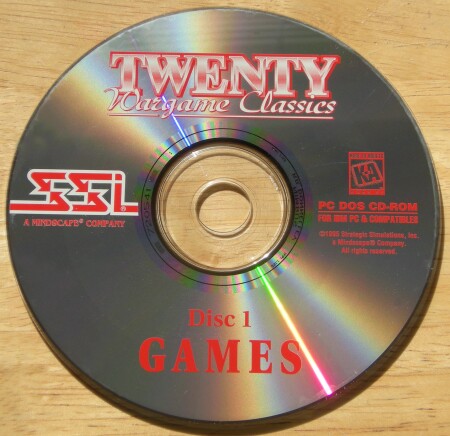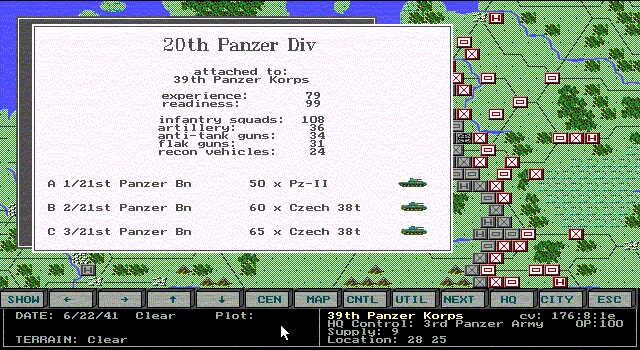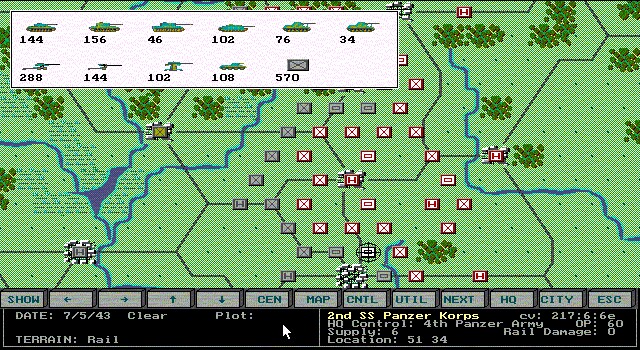
Actual Game
Gary Grigsby's
|
The Game
War in Russa covers the epic struggle between Germany and Russia 1941-45. The game was designed by Gary Grigsby, the most prolific wargame designer in the relatively short history of computer wargaming. This is Mr. Grigsby's third treatment of this subject for SSI. The first, with the same title, was an 8-bit effort in 1984. In 1990 came Second Front, one of the first of the 16-bit wargames (along with 360's Harpoon and Panther's Fire Brigade.) War in Russia owes much of it's structure to this second effort. In reviewing this game it will thus be necessary to compare many of it's features to this classic predecessor.
Like all Grigsby strategic vehicles, WIR combines a very large play area and number of military units with considerable detail in the makeup of these units, including many models of armored fighting vehicles and aircraft.
War in Russia is played in weekly turns starting (in the full campaign game) on June 22,1941 and ending in July 1945. Scenarios covering various campaigns during the war (and of shorter duration) are included.
The map area in WIR covers the entire area of the conflict (except for the central and northern areas of Finland which were virtually static anyway) and most of Germany and central Europe as well. The west border is the Ruhr industrial area, east goes some 180 miles east of Stalingrad. The north border is some 100 miles north of Helsinki Finland and the south border is the Baku area. Thus unlike many boardgames covering the subject the true historical objective of the '42 German offensive (Caucasus oil fields) is included as well as what became the objective in fact (Stalingrad.)
WIR uses an extremely detailed and elegant system to portray both the military forces and the industrial base supporting it. Each turn manpower, in the form of squads, is recruited from each friendly city in the home country, resources and oil are gathered from controlled sources, factories (aircraft, AFV, gun, flak) contribute according to their production rate. the rate is set by the capacity of the factory and the expense of the unit being produced, all measured in points. All these are contributed into a central pool.
Essentially, either player controls all the men and equipment of his entire armed forces down to the squad, aircraft and vehicular level. The shells are the method used for organizing, supplying, moving and fighting with these forces. This is one of the game's strongest points and reflects an accurate portrayal of how the war functioned. Unlike a boardgame where divisions might be eliminated never to return, in WIR an eliminated shell will simply reappear back in the home country with no forces attached and begin to absorb new replacements so as to rebuild.
WIR uses HQ's, leaders and corps to actually organize the armed forces. HQ's have units assigned directly to them (where they rest and build up faster) or control corps. Corps are the actual units of maneuver (or playing pieces) in the game that do the moving and fighting. Each HQ has a leader assigned to it which will effect the efficiency of units it controls. leaders are rated on a scale from 9 (very good) to 1 (awful.) HQ's start at the national armed forces level (Stavka and OKW) and go to the theater, army group and army level. HQ's also have air groups attached and are where air strikes are launched from.
WIR simulates not only the eastern front but for the German player abstract treatments of the war in the West and North Africa/Italy. thus the German player has the entire roster of all German ground and air forces. He will be forced to maintain a percentage of these in these other fronts (represented by HQ's) and if he fails to maintain a historical level the progress of these campaigns (as represented by a timeline of historical rates of progress) will accelerate. So, if one strips the panzers in the west be prepared to see Patton roll into Paris in 1942! The Soviets maintenance of forces in Siberia is not represented. WIR besides Germany and Russia, also features forces from all Axis satellite nations (Italy, Rumania, Hungary, etc) and the allies (the abstract treatment of the U.S. and England INCLUDING the allied strategic bomber campaign against German industry.
Divisions, regiments, battallions, etc have forces alloted to them such as infantry squads, guns, armored fighting vehicles (AFV's), etc. They will have a readiness rating (reflecting at any point in time what percentage of the forces attached are actually capable of combat (i.e. the percentage not capable reflects fuel and ammunition shortages, broken down equipment, exhausted troops, etc.) WIR highlights 58 different AFV types (rated in attack, defense and production cost) and 54 air unit types rated in 6 categories (maneuverability, cannon, load, endurance, durability and production cost) and has generic yearly ratings for infantry squads, anti- tank guns, artillery, flak and recon units.
When combat is resolved it is in the matching up of tank battalions, infantry divisions, artillery battalions, etc. Though the player may elect not to watch resolution in such exhaustive detail (especially when large forces are involved) it does take place at this minute number crunching detail.
WIR is played sequentially, first the Axis player and then the Soviet. Each player turn consists of two phases. Phase one is the orders part of the turn. One can look at and adjust industrial production, transfer air units (no range limit) move forces by rail and move units within friendly territory (that territory each player started the game controlling plus territory acquired from the enemy by moving units through it.) Also it is during this phase that air strikes are conducted and units are given movement plots to enter enemy held territory. During the second phase (completely computer controlled) movement plots are executed and results determined.
Ground Movement - Ground units may move through friendly territory during the planning phase as long as they start and end up in friendly controlled territory. infantry corps can now move a maximum of 5 hexes and mechanized a maximum of ten (in Second Front this was unlimited and made for unrealistically long movements.) Grounds units may now move from one HQ or corps to another HQ or corps with a rail transfer option, though both the locations of origin and terminus must be on controlled rail lines.
Air Operations - This is where some of the biggest improvements have been made from Second Front. Each air group can be assigned a mission from several choices (escort, CAP, interdiction, airfield attack, air lift, etc.) The restrictions on which missions can be flown by various types of aircraft have been tightened up (i.e. a dive bombing Stuka can no longer make a strategic attack) for more realistic usage. In Second Front each HQ with attached aircraft could launch one type of attack (plus a separate airlift operation if transport planes were present.) With air group mission assignment players can now divide up the assets of one HQ and launch several smaller strikes. Escort fighter will fly more then one mission. Bombers will fly one mission per turn.
The supply system in WIR is run primarily by the computer. Each units has a "readiness" rating. readiness is a catch all term used to represent what percentage, out of %100, of a units's assets are able to perform operations at a given point in time. Into readiness are factored such things as fuel availability, fatigue, broken equipment, etc. A unit starting the game may have a 99% rating and be very powerful force indeed. This same unit in the middle of a swamp in a Siberian blizzard strung out on a long supply line might have a 3% readiness rating and be almost impotent.
One of the biggest additions to WIR is also the operations points function. In Second Front each HQ had a 5x11 hex zone of control and units in that zone were attached to that HQ. Problems would arise when HQ's had overlapping zones and one would find corps constantly changing HQ affiliations. Also there was no real limit to the number of units that could be attached to particular HQ which made for unrealistically sized armies of 70 divisions or more under the game's top leaders. Operations points solves alot of these problems in WIR. These points are generated by the amount of heavy industry, oil and resources each side has and are then distributed to HQ's. As units perform various movement and combat functions these points are expended. The amount available to an HQ can have a positive or adverse effect on operations and combat. Thus the more corps attached to an HQ the faster the operations points drain away. This forces players to maintain realistically sized armies of four or five corps.
For its time WIR was THE wargame covering the eastern front. For scope, detail, and options it simply has no competition. While WIR essentially uses the same game system and data base that Second Front did it has so many new features, refinements and improvements that it is well worth the investment for wargamer interested in the period, even if he or she already has Second Front. This period of time seems to be the age of the sequel, be it movie, book or game. Games such as Carriers at War, Railroad Tycoon, Warlords and Pirates have had sequels released relatively soon after the initial product. In terms of overall value War in Russia more than holds it's own as an improvement over an existing game system.






